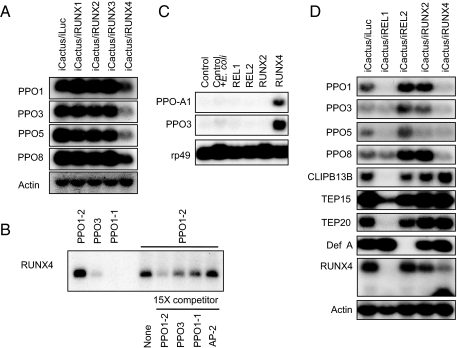Fig. 3.
Direct activation of four immune-inducible PPO genes by RUNX4. Only RUNX4 depletion compromised the activation of these genes by Cactus depletion (A). Gel mobility-shift assay revealed the direct binding of RUNX4 to mosquito RUNT binding motifs (B). Two predicted motifs from PPO1 gene promoters, PPO1–1 and PPO1–2, and a motif from PPO3 were used for binding and competition assays. RUNX4 specifically activated the Drosophila PPO genes in Drosophila S2 cells (C). Drosophila PPO-A1 (bc) and PPO3 genes were activated by Aedes RUNX4 in Drosophila S2 cells. The activation of Drosophila PPO-A3 was not detected using this Northern analysis. The transcriptional activation of PPOs by Cactus depletion was compromised by both REL1 and RUNX4 (D). Defensin A was only partially activated by Cactus depletion (less than 10%, compared with full activation at 5 h after E. cloacae challenge; data not shown), and the activation by Cactus depletion was compromised only by REL2. This suggests that Cactus depletion partially activates the IMD pathway, which is independent of the REL1 transcription factor. CLIP-B13B and TEPs were shown to be regulated only by REL1, not by RUNX4. The transcript knockdown for each RUNX was confirmed by means of RT-PCR analysis (Fig. S8).

